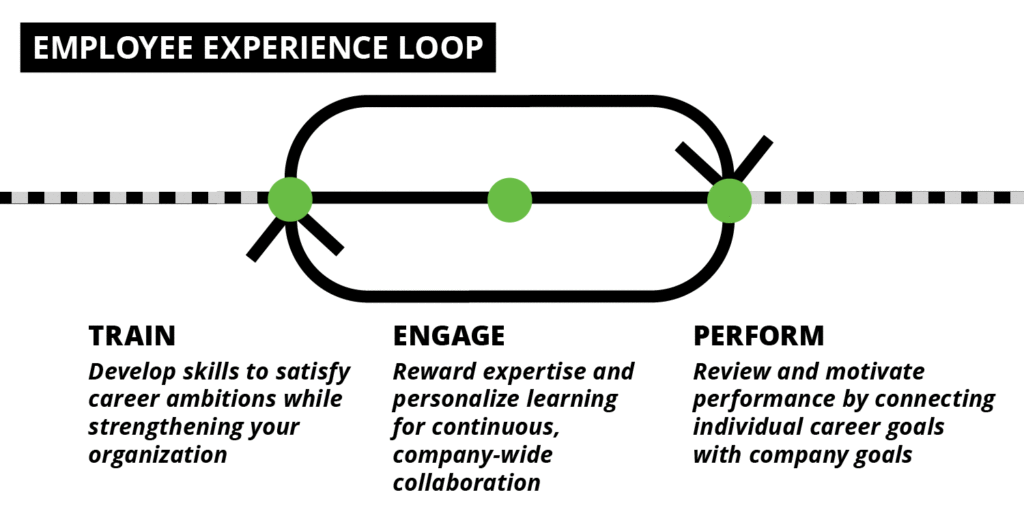Gamification in the workplace can be a double-edged sword.
On the unfavorable end of that sword, one Disneyland Resort Hotel’s employee gamification campaign resulted in workers skipping bathroom breaks and scornfully dubbing it the “electronic whip.”
Such extreme results contradict Samsung’s experience, which reduced training costs by 40% and increased sales of premium devices by 64% when using gamification.
Samsung’s success and Disney’s drastic failure raises an important question: What’s the right approach to workplace gamification?
I’ll share the answer in this post. You’ll learn why attempts to use gamification to increase employee engagement fail and the 3 evergreen gamification tactics that every organization can rely on.
Table of contents:
What exactly is gamification in the workplace?

Gamification in the workplace is the science of tapping into the intrinsic motivators of employee experience to drive behavioral change, engagement and sustained productivity in a corporate environment.
As explained in the next section, corporate gamification isn’t about simply transposing video game mechanics into the workplace. It’s about identifying challenges within the business that are best solved by employee recognition and reward systems that power behavioral change.
Gamification to improve employee engagement: Why most fail
When using gamification in the workplace, transformational and sustained change occurs when the underlying strategy is to solve pressing problems and focus on the critical aspects of employee experience. Corporate gamification should:
-
Develop the skills of employees: In addition to mandatory compliance training, gamification can help employees hone their craft or learn the skills they need to address bottlenecks within the business and progress their careers
-
Instill important habits: If employees possess the knowledge to solve a problem or improve an aspect of the business, but aren’t applying it, feeding them more information won’t solve anything as the issue is behavioral
In this case, gamification can reinforce behaviors and habits that benefit the business by rewarding top-performers and (in some cases) providing real-time feedback to complement effective performance management
-
Encourage a collaborative culture: Are subject matter experts and employees in general, recognized for helping team members and sharing knowledge?
Gamifying the process of sharing knowledge by recognizing experts with tools such as ratings, curated playlists and dedicated workspaces improves collaboration in your workplace, shortens learning curves and makes it easier to identify top-performers

Ultimately, addressing the fundamental drivers of employee performance (we call this talent experience at Totara) means you’re recognizing, rewarding and paying attention to the long-term motivators of employee engagement while solving business problems.
Blinded by the misconception that gamification in the workplace is about making things “fun,” many forgo the fundamentals of talent experience and fail to tailor initiatives around their unique workplace.
This was the mistake made by the Pharmacy software company, Omnicare. Aiming to decrease helpdesk wait times, it gamified customer service procedures by rolling out an employee leaderboard and offered cash incentives for fast-responding employees.
The well-intentioned strategy backfired ; staff viewed the initiative as “Big Brother” attempting to watch over them and helpdesk wait times—alongside employee turnover—increased.
Gamification in the workplace fails because organizations:
-
Use short-term initiatives that offer temporary boosts in engagement (would employees really value a $5 gift card or would they prefer a certification proving their expertise?)
-
Apply a generic approach that’s ill-suited for their workplace (e.g. Omnicare using retail style customer service gamification on specialist knowledge workers)
-
Fail to make employees feel valued, and in extreme cases, surface suspicions of micromanagement
-
Focus on the medium (gamification) instead of diagnosing the root cause of the problem
3 evergreen gamification tactics that work
Now that you know when to use (or avoid) gamification, let’s dive into the evergreen tactics and workplace gamification examples that will help you improve employee engagement.
-
Gamification for training employees
Workplace learning is generally centered around overcoming a challenge, whether that’s mastering a new skill, becoming an expert on a new product line, understanding the laws in your market or something totally different.
Context is key when you’re implementing gamification for employee training. It needs to make sense within the course, activity or topic. Ideally, the gamified elements should enhance the narrative and journey throughout your course.
For example, when Amazon launched its Alexa Academy to improve expertise around core products (Echo, Alexa and Kindle), it used completion-based badges to reward learners and give them expert status.
Learners who became Fire TV Customer Experts would unlock new areas of the site and be entered into a competition.
-
Gamification to improve job-specific performance
Another way to use gamification to improve employee engagement is to cultivate job-role-specific competencies and behaviors that benefit the business.
For example, let’s say your goal is to improve retention with better customer service. Your gamification efforts should focus on cultivating stronger service-related skills and rewarding behaviors and results that exhibit great customer service.
This is exactly what Deloitte Accountancy, one of the four largest accounting firms in the world, did to adapt to accelerated digitalization triggered by the COVID-19 pandemic.

After surveying clients, the firm identified 9 make-or-break stages in the accountant-client relationship.
Empowered by these insights, Deloitte Accountancy’s training team used the Totara Learn LMS to create ClientFit, an award-winning, Netflix-themed interactive employee training program that coached its employees through (and quizzed them on) the pivotal stages and key expectations in the customer lifecycle.
This gamified approach earned an 87% completion rate for 500 employees, and more importantly, equipped Deloitte’s consultants with (generally hard to teach) softs skills to improve client retention and deliver an exceptional customer experience.
-
Gamification to empower a collaborative culture
When Mitchells & Butlers, the umbrella brand for over 1,700 pubs, cultivated a collaborative environment, it immediately improved engagement. As a result, compliance rates reached 89% and food quality scores increased by 5% across the board.
Gamification can help build a collaborative culture with a learning experience platform by recognizing and rewarding employees for sharing knowledge, mentoring and helping each other.
From brand-new employees to experienced senior management, an LXP connects people with similar needs—whether that’s by role, location, seniority level or skill set.
Not only will this help your people share knowledge, collaborate on projects from a central digital workspace and communicate with colleagues, but it also opens up the opportunity for developing employees to be mentored by senior experts.
Experts can curate training resources from multiple channels to create personalized development paths and answer questions from mentees—who can comment on and rate content created by others.
This provides employees a dedicated place to develop their skills, discuss ideas with colleagues and solve problems together in an engaging and interconnected way.
Do you really need gamification? Ask these 5 questions to find out
To avoid running the wrong type of workplace gamification campaign, or even worse, wasting resources on gamification when it’s the last thing your people need, develop a strong use case and structured process for deploying it.
The key here is to have a strong hypothesis for the behavioral change you want to inspire (employees should fill out CRM data) and the outcome it generates (improve lead scoring and qualification to reduce acquisition costs).
This allows you to determine what gamification tactics and mechanics to deploy ( e.g. a leaderboard that rewards employees for accurate data entry into the CRM system).
As with all approaches to employee engagement, the impact gamification will have depends on how it’s implemented. Saying “I want to gamify xyz” and shoehorning it wherever possible is the wrong approach—and often turns “games” into unnecessary distractions.
Before taking the plunge into gamification, here are seven key questions you should ask yourself:
1. What’s the challenge or opportunity?
Different types of workplace challenges require different solutions.
Corporate gamification revolves around overcoming challenges or improving processes. You should know what these challenges and opportunities are because gamification isn’t the answer to every bottleneck or challenge your people face.
If, for example, production rates are slowing due to users not being able to troubleshoot technical issues on an assembly line, a simple checklist or training course will do the job; there’s no need to “encourage friendly competition” with convoluted leaderboards and traffic lights systems.
If, however, the cause of impeded production is employees not entering the correct dimensions on a system, introducing a scoring system for their data input makes sense (and also allows you to measure the correlation between data entry and production rates).
2. What does a successful campaign look like?
Once you’ve identified what you want to improve and you’re certain that gamification is the right choice, envision what success looks like with your team.
Continuing from the above example of introducing a scoring system that rates the quality of data entered by employees, success might look like:
-
Improved production rates
-
Fewer assembly line errors
-
Less total downtime
3. How will you implement the campaign?
Gamification can add a whole extra level of manual intervention from managers or administrators. So you’ll need to identify whether your systems and workflows support automated tracking, or if you’ll need to create new processes.
4. Who’s the target audience?
Depending on their job roles and collective attitude, different departments will be motivated (or demotivated by) different challenges. Knowing your audience and tailoring your gamification campaign around them, is therefore vital.
It spells the difference between employees feeling demotivated from micromanagement or feeling extremely empowered by a sense of autonomy.
5. Is this a good idea?
Perhaps the most important question on your list should be: Is this a good idea?
Gamification will be just one part of your overall employee engagement strategy, so ensuring that it’s capable of moving the needle is key.
Author bio: Hassan Uddeen is a freelance writer, content strategist and SEO


